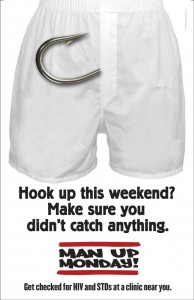Don’t “Fool” Around with STIs – “Man Up” and Get Tested
April Fools’ Day marks the kick-off of STD Awareness Month, a month dedicated to drawing attention to the 20 million new STIs (“I” for infections) that affect people in the United States each year.  The best ways to decrease the spread of STIs, including HIV, are to use condoms during every sexual encounter and to get tested regularly. Unfortunately, many people do not do these things consistently.
The best ways to decrease the spread of STIs, including HIV, are to use condoms during every sexual encounter and to get tested regularly. Unfortunately, many people do not do these things consistently.
Why men?
Men tend to practice “reactive health care” meaning that instead of preventing STIs or treating symptoms early, they wait until their problems get worse before they visit a doctor. The problem with STIs is that people who are infected may not have any symptoms. If men get tested only when they have symptoms, they may not get tested at all. That means if they have an STI, they may end up unintentionally infecting others.
Public health practitioners struggle with how to encourage men to engage in prevention and early detection of sexual health issues. How do we help men form good habits around their sexual health? One way is to disseminate health communications about testing and condom use on Mondays, when people are most receptive to health messages.
Why Monday?
First, the week is a critical unit of time in shaping human behaviors. We plan our lives by the week to keep track of where we’ve been and where we’re going. Because of this, we are more receptive to messaging that taps into our natural, weekly rhythm. Monday marks the start of the week – a day for a “fresh start.”
Second, people already see Monday as a day for health. A nationwide survey conducted by FGI Research, Inc., asked participants what day they were most likely to try a healthy behavior such as beginning a diet, starting to exercise, scheduling a doctor’s appointment, or quitting smoking. Overwhelmingly, respondents said that Monday is the day they would start these behaviors. This trend is also consistent with Google searches for “healthy” terms (i.e. “healthy recipes,” “healthy weight,”): Searches were higher on Monday than any other days of the week, demonstrating that people are actively thinking about their health on Monday.
Third, there is a spike in the number of heart problems, strokes, and suicides on Monday, which researchers attribute to stress, unhealthy weekend behaviors, and disruption of sleep cycles. By promoting healthy behaviors on Monday, public health practitioners foster a transition back to a healthy, structured routine that has the potential to improve these poor health outcomes.
Time to “Man Up”
To encourage men to start thinking about their sexual health, The Monday Campaigns – a non-profit public health initiative most known for “Meatless Monday” – created Man Up Monday, a creative campaign that sends a sex-positive message to young men, encouraging them to use Monday as the day they think about their sexual health choices, get tested for HIV and STIs, and restock their condoms. The campaign features eye-catching images and humorous, cheeky messages. One poster features boxers with a fishhook poking out of the fly. The copy reads, “Hook up this weekend? Make sure you didn’t catch anything.”
Man Up Monday provides a free creative platform for health clinics, universities, non-profits, and other organizations to advertise their existing sexual health services and increase the number of men who come in to get tested. The campaign has grown tremendously over the last couple of years, with participants all over the country, such as Planned Parenthood of Southeast Virginia, The Harlem Health Promotion Center in New York City, and Murray State University in Kentucky.
How can I Man Up?
Make Monday the day you think about sexual health. Restock your condoms on Monday. Call your doctor or clinic on Monday to make an appointment to get tested for HIV and STIs. Take time on Monday to reflect on the sexual health decisions you made over the weekend. Establish habitual thinking about your sexual health, and keep yourself and your partner safe.
To learn more about Man Up Monday, start your own campaign, and get free creative materials, visit the campaign website, Facebook, and Twitter.



